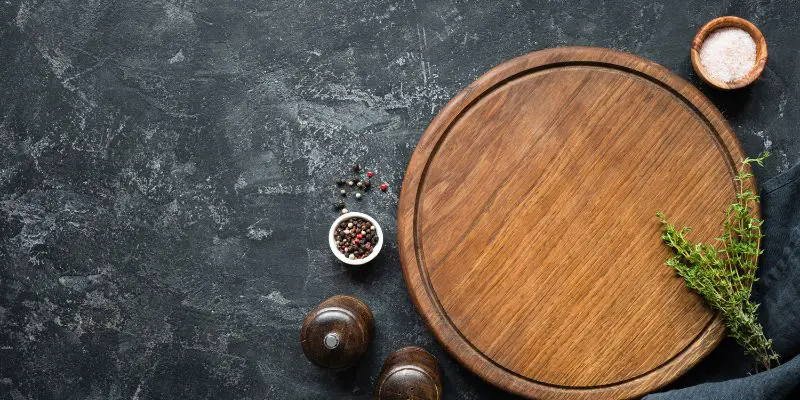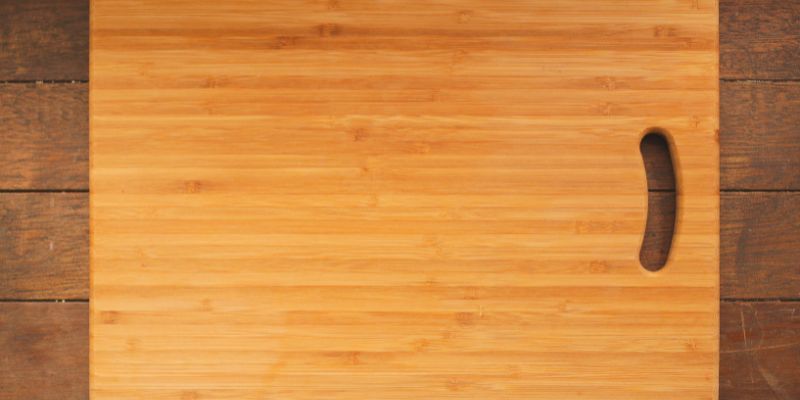Yes, mahogany is good for a cutting board because it is durable and has natural antimicrobial properties. Mahogany is an excellent choice for a cutting board due to its durability and natural antimicrobial properties.
This dense hardwood is known for its rich, reddish-brown color and tight grain, making it resistant to knife marks and scratches. Additionally, mahogany contains natural oils that help inhibit the growth of bacteria, further enhancing its suitability for food preparation.
Whether you’re slicing vegetables or carving meat, a mahogany cutting board offers a sturdy and hygienic surface. However, it’s crucial to properly maintain and oil the cutting board to keep it in optimal condition. With its combination of strength and natural antimicrobial properties, mahogany is a reliable choice for a cutting board that will withstand daily use in the kitchen.
Is Mahogany A Suitable Material For A Cutting Board?
When it comes to choosing the right material for a cutting board, there are several factors to consider. One such material that often gets attention is mahogany. Known for its beauty and durability, mahogany has been used in various applications, including furniture and musical instruments. But is mahogany a suitable material for a cutting board? Let’s take a closer look.
Mahogany is a hardwood that is widely known for its rich reddish-brown color and stunning grain patterns. It is known to be highly durable, making it a popular choice for high-quality furniture. Additionally, mahogany has a natural resistance to pests and rot, which adds to its durability.
Using mahogany for cutting boards comes with several benefits that make it a desirable choice for many people. Here are some of the key advantages:
- Durability: Mahogany is a dense hardwood that is resistant to both wear and tear and moisture damage. This makes it highly durable, ensuring that your cutting board will last for years to come.
- Knife-friendly: Mahogany has a tight grain structure that makes it gentle on knives, reducing the risk of dulling or damaging the blade. This makes it a preferred material for those who want to maintain the sharpness of their knives.
- Natural antimicrobial properties: Unlike some other materials, mahogany naturally inhibits the growth of bacteria and other microbes. This can be a significant advantage in a cutting board, as it helps to maintain a hygienic surface for food preparation.
- Attractive appearance: Mahogany’s warm and rich color, along with its beautiful grain patterns, adds an elegant touch to any kitchen. It can enhance the aesthetic appeal of your kitchen countertops or serving tables when used as a cutting board.
While mahogany does come with its share of benefits, it is important to consider the drawbacks and special considerations before choosing it as a cutting board material. Here are a few points to keep in mind:
- Price: Mahogany is considered a premium hardwood, which means that it can be more expensive compared to other types of cutting board materials.
- Weight: Due to its density, mahogany can be heavier than other types of cutting board materials. This may not be an issue for everyone, but if you prefer a lightweight cutting board, you may want to consider alternative options.
- Maintenance: Mahogany requires regular maintenance to keep it in optimal condition. It is recommended to oil the cutting board periodically to prevent it from drying out or developing cracks.
In conclusion, mahogany can be a suitable material for a cutting board, offering durability, knife-friendliness, antimicrobial properties, and an attractive appearance. However, it is important to weigh the drawbacks and considerations, such as the price, weight, and maintenance requirements, before making a final decision. Ultimately, the choice of material depends on your personal preferences and needs.

Introduction To Mahogany As A Cutting Board Material
When it comes to choosing the right material for a cutting board, one option that stands out is mahogany wood. Known for its exceptional durability and stunning appearance, mahogany has been a popular choice for various woodworking projects. But is mahogany good for a cutting board? In this article, we will delve into the world of mahogany wood and explore the unique characteristics that make it an ideal material for cutting boards.
Overview Of Mahogany Wood
Mahogany wood is derived from the tropical hardwood trees of the family Meliaceae. It is characterized by its rich reddish-brown color and often displays a straight or interlocked grain pattern. This wood variety is highly prized for its natural beauty, which lends itself well to various furniture and decorative applications.
One of the prominent factors contributing to the popularity of mahogany is its exceptional durability. Thanks to its high natural oil content, mahogany wood exhibits excellent rot resistance, making it suitable for outdoor projects as well.
Characteristics That Make Mahogany Ideal For Cutting Boards
Density and Hardness
Mahogany wood is moderately dense with a Janka hardness rating of approximately 800-900 pounds-force (lbf). This makes it tougher than some other common hardwoods used for cutting boards, such as maple. Its sturdy density ensures your mahogany cutting board can withstand heavy knife usage without showing significant signs of wear and tear.
Natural Oils and Antimicrobial Properties
Mahogany is blessed with natural oils that not only enhance its lustrous appearance but also contribute to its antimicrobial properties. These oils help prevent the growth of bacteria and other microorganisms, which is crucial when it comes to maintaining a hygienic cutting surface.
Less Pronounced Knife Scarring
While no wooden cutting board is completely immune to knife marks, mahogany’s tight grain structure and hardness contribute to reducing the visibility of knife scarring. This means that even after extensive use, your mahogany cutting board will maintain a relatively smooth surface, preserving its natural beauty.
Easy on Knife Edges
Another noteworthy characteristic of mahogany is its forgiving nature when it comes to your precious knife edges. Unlike some harder woods that may dull the blades, mahogany strikes a fine balance between hardness and softness, ensuring that your knives retain their sharpness for longer.
Low Maintenance
Mahogany cutting boards are relatively low maintenance compared to some other wood types. Regular oiling and periodic conditioning with food-grade mineral oil will suffice to keep your mahogany cutting board in top-notch condition. However, it is essential to avoid exposing it to excessive heat or moisture, as this can negatively affect its longevity.
With its durability, natural beauty, and unique characteristics, mahogany wood presents an excellent choice for those looking to invest in a high-quality cutting board. Now that we’ve explored the overview and outstanding features of mahogany as a cutting board material, it’s time to consider the specific uses and considerations in more detail.
Benefits Of Using Mahogany For Cutting Boards
Mahogany is a popular choice of wood for cutting boards due to its exceptional benefits. From superior durability and resistance to moisture and rot to natural antibacterial properties and gentleness on knife blades, mahogany brings a range of advantages that make it an excellent material for cutting boards.
Superior Durability And Longevity
One of the primary benefits of using mahogany for cutting boards is its superior durability and longevity. Mahogany is incredibly dense and hardwood, which means it can withstand the everyday wear and tear in a bustling kitchen. This durability ensures that your mahogany cutting board will remain in pristine condition, resisting scratches, dents, and cracks.
Resistance To Moisture And Rot
Mahogany possesses a natural resistance to moisture and rot, making it an ideal choice for cutting boards. Unlike other woods that can easily absorb water and distort over time, mahogany maintains its shape and structure even when exposed to moisture. This resistance to rot ensures that your cutting board will last for years to come, maintaining its quality and appearance.
Natural Antibacterial Properties
One of the remarkable aspects of mahogany is its natural antibacterial properties. When used as a cutting surface, mahogany actively inhibits the growth of bacteria, making it a hygienic choice for food preparation. These antibacterial properties help minimize the risk of cross-contamination and ensure a safer cooking environment.
Gentle On Knife Blades
Unlike harder materials like glass or stone, mahogany is gentle on knife blades. The natural density of mahogany provides enough firmness for cutting and slicing while also absorbing the impact, minimizing damage to your knives. This gentleness on knife blades ensures that they remain sharper for longer periods, reducing the need for frequent sharpening.
Drawbacks And Considerations Of Mahogany Cutting Boards
While mahogany is a popular choice for furniture and interior applications, it may not be the best option for a cutting board. Before investing in a mahogany cutting board, it’s important to consider the drawbacks and limitations that come with this choice.
High Cost Compared To Other Materials
One of the major considerations when purchasing a cutting board is the cost. Mahogany is known for its beauty and durability, but it also comes with a higher price tag compared to other materials commonly used for cutting boards. If you’re on a tight budget, a mahogany cutting board may not be the most economical choice.
Requires Regular Maintenance And Care
Maintaining a mahogany cutting board requires regular attention and care. Unlike some other materials that are more forgiving, mahogany is a softer wood that can easily absorb moisture and food particles. To keep your cutting board in top condition, it’s essential to clean it thoroughly after each use, dry it properly, and regularly apply a food-safe oil or wax to prevent drying out and prolong its lifespan.
Potential Sensitivity To Changes In Humidity
Mahogany cutting boards can be sensitive to changes in humidity levels. The wood may expand or contract in response to ambient moisture, leading to warping or cracking. If you live in an area with high humidity or experience drastic fluctuations in humidity throughout the year, you may need to take extra precautions, such as storing the cutting board in a controlled environment or using a humidity-regulating device.

Limited Availability And Sustainability
While mahogany is a beautiful hardwood, it is not as readily available as some other types of wood commonly used for cutting boards. This limited availability can make it more challenging to find a mahogany cutting board that meets your specific criteria. Additionally, sustainability is a significant concern when it comes to mahogany. Some varieties of mahogany are endangered or protected, and using illegally logged or unsustainable sources can contribute to deforestation and harm the environment.
Considering these drawbacks and considerations is essential when deciding if a mahogany cutting board is the right choice for your kitchen. While it offers natural beauty and durability, the higher cost, regular maintenance requirements, sensitivity to humidity changes, and limited availability make it important to weigh your options carefully.
Frequently Asked Questions For Is Mahogany Good For A Cutting Board
Is Mahogany A Good Wood For A Cutting Board?
Mahogany is a popular choice for cutting boards due to its natural antimicrobial properties. Its dense, fine-grained structure prevents bacteria from penetrating the surface, making it hygienic and easy to clean. Additionally, mahogany’s durability and resistance to warping and splitting make it a great option for a long-lasting cutting board.
Does Mahogany Impart A Taste Or Odor To Food?
No, mahogany does not impart any taste or odor to food. Unlike some other types of wood, mahogany is neutral in flavor and does not transfer any unwanted smells or tastes to your ingredients. This makes it an excellent choice for a cutting board, as it will not affect the taste of the food you are preparing.
How Do I Properly Care For A Mahogany Cutting Board?
To properly care for a mahogany cutting board, it is recommended to hand wash it with warm soapy water after each use. Avoid soaking the board or leaving it wet for extended periods of time, as this can cause warping or cracking.
Regularly oil the board with food-safe mineral oil to keep it moisturized and maintain its beauty and durability.
Can A Mahogany Cutting Board Withstand Heavy Daily Use?
Yes, mahogany is known for its durability and can withstand heavy daily use. The dense nature of mahogany wood makes it resistant to knife marks, cracking, and warping over time. With proper care and maintenance, a mahogany cutting board can provide years of reliable service in your kitchen.
Conclusion
So, is mahogany a good choice for a cutting board? Without a doubt, yes! Its natural durability, resistance to moisture, and stunning aesthetics make it an excellent material for this kitchen essential. With proper care and maintenance, a mahogany cutting board will provide a reliable and stylish surface for all your shopping needs.
Trust in the elegance and practicality of mahogany to enhance your cutting experience in the kitchen.


